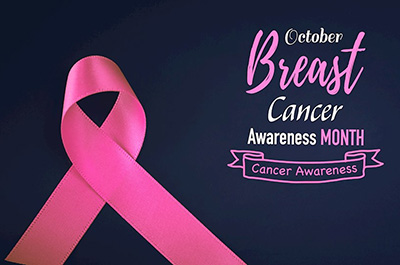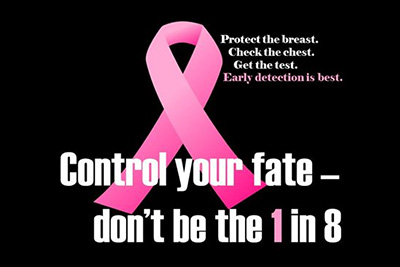October is Breast Cancer Awareness Month, and the National Breast Cancer Awareness Foundation (NBCAF) urges people to increase their awareness of the signs and symptoms of this disease. Breast cancer develops predominantly in women after the age of 40; however, check ups every couple of years and a healthy diet are a good idea for those under 40 as well.

According to the American Cancer Society, the risk of a woman in the United States developing breast cancer in her life is about 12 percent. There are more than 3.1 million breast cancer survivors today in the United States.
The Johns Hopkins Medical Center urges adult women of all ages to perform breast self-exams at least once a month. “Forty percent of diagnosed breast cancers are detected by women who feel a lump, so establishing a regular breast self-exam is very important,” according to Hopkins’ website.
According to the NBCAF, symptoms can typically include the following:
- A change in how the breast or nipple feels
- A change in the breast’s skin texture, including becoming scaly, red, or swollen
- Clear or bloody nipple discharge
- Nipple tenderness
- Thickening near the breast or underarm
Breast self-exams can be performed on the same day each month in the shower, in front of a mirror, and/or lying down. Using a circular motion and medium pressure, check both breasts and armpits, feeling for any lump, thickening or knot that feels hard.
The American Cancer Society recommends that mammograms begin for most women at age 45, but in many cases, younger women may also be candidates for this procedure. While annual mammograms do not provide all the answers for women, they do offer a starting point.
“Breast cancer is more easily treatable after women get into their 40s. If it develops before that age, it tends to be more violent and harder to treat,” said Julie Sanz, a registered nurse at Stevenson University’s Caves Wellness Center. The reason for this is the higher estrogen levels in younger women, but the higher the age, the higher the risks both of developing the cancer and receiving proper aid after discovery.
Typically, pain in either or both breasts is not a warning sign of cancer, but it merits a discussion with a doctor.

Men can also develop breast cancer, but this is highly unlikely because men typically have less fat and no estrogen. However, if there is a hard, noticeable lump in the breast or armpit area, men should not be afraid to get it checked. Furthermore, finding a lump does not necessarily indicate the presence of breast cancer. “Out of the 63 scares I have dealt with, only two had to be checked multiple times, and none ended up having cancer,” said Sanz.
Breast cancer is the second leading cause of cancer death among women, just behind lung cancer, according to the National Breast Cancer Awareness Foundation. The quicker the cancer is caught, the easier and faster it can be properly treated. A healthy diet can help lower the chances of getting breast cancer, and check ups every couple years after 40 will let people know if they need to take further action.

























































